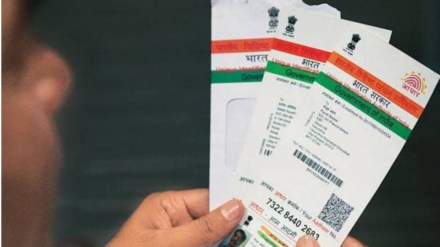A new Aadhaar app was launched this week, with the promise that it would make Aadhaar verification “as simple as making UPI payment”. The idea is uniquely Indian as it incorporates QR codes, and is expected to solve the hassles faced in offline know-your-customer processes, explains Anvitii Rai
l How Aadhaar verification will work via the app?
THE NEW M-AADHAAR app has been developed in partnership with the Unique Identification Authority of India (UIDAI). Identity verification through the app will require the Aadhaar app and a QR code at the point of authentication, which could be a bank, airport, hospital or even examination centres — basically any place which requires individuals to get their identity authenticated. The person whose identity is to be verified will need to scan this QR code through the m-Aadhaar app.
By doing so, authentication will be instant, and for an added layer of security, real-time face verification will also be required. The ID details such as name, age, address, etc., would be sent from the user’s phone securely rather than externally, eliminating a middle layer to ensure digital privacy. At the launch of the app, minister for electronics & IT Ashwini Vaishnaw said, “No need to hand over Aadhaar photocopy at hotel receptions, shops or during travel. The Aadhaar App is secure and shareable only with the user’s consent. 100% digital and secure.” It is currently in the beta testing stage.
l What issues does this update aim to solve?
THE FIRST ISSUE was the need for physical copies of the Aadhaar, which will no longer be necessary. Much like the UPI QR codes that are available everywhere now, such Aadhaar authentication QR codes can also be circulated to points of authentication. This will significantly cut down the requirement of biometric machines such as fingerprint or iris scanners, which has been the norm till now. Additionally, carrying copies of the Aadhaar often left citizens vulnerable to attempts at duplication and misuse. Speaking to FE, Pankit Desai, CEO and co-founder of Sequretek, a cybersecurity firm, said,
“Face ID based verification is a great step as it removes the need for carrying, sharing Aadhaar documents for purposes of verification. One of the key concerns always was the potential for abuse for data in transit, as you do not know what happens to the data which was shared with the intermediary before it makes it to a system.”
l What more is required from the app
WHILE THIS IS a monumental first step, the app still has room to grow. The biggest is to ensure that this system works in backward areas as well. Currently, the app only works for smartphones. India does have the second-highest smartphone penetration rate globally, but it still stands at 46%, which means that a majority of the population will still not be able to avail of all the benefits that this m- Aadhaar upgrade provides. Thus, looking ahead, a system must be established so that this app can be used by those who own feature phones too. It must be noted that such a non-smartphone option exists already within the Indian digital public infrastructure—UPI payments can be done without a smartphone by dialing *99#, which connects the user to a UPI menu, as well as through UPI123Pay, which provides feature phone users with multiple options. There could also be a potential use-case for Aadhaar enabled payment system (AePS) down the road.
l How it differs from Digi Yatra app
DIGI YATRA AND app-based Aadhaar verification are only similar insofar as face ID is concerned. Beyond that, the use-cases for both apps are different. The new m- Aadhaar app would be used to simplify personal verification at places where such authentication is required.
On the other hand, Digi Yatra is solely for making travel at airports easy, and more importantly, is linked to a boarding pass. While the Aadhaar app uses face ID as the final step in the authentication process, Digi Yatra uses face ID at different points within the airport to ensure a contactless and seamless travel experience. While Digi Yatra uses Aadhaar to verify identity as well, its use is markedly different, and thus, it will not be rendered useless owing to this upgrade for m-Aadhaar.
l ID verification systems elsewhere
INDIA IS AT quite a unique position when it comes to digital public infrastructure, as it has the largest population in the world. To deal with the same, innovation in this space is more of a necessity. Thus, it makes sense that India is quite ahead in this sphere. For most countries, social security numbers or similar ID markers are usually verified online. For example, the US verifies social security numbers via the online portal of the concerned department. The system that resembles the m- Aadhaar the most is the United Arab Emirates’ (UAE) Emirates ID, which is a mandatory document. The UAE Pass app was launched in 2018, and allows citizens to be registered through face ID, following which they can share and sign digital documents, as well as update their details as and when it is needed. However, QR-based ID verification appears to be, for now, uniquely Indian.
